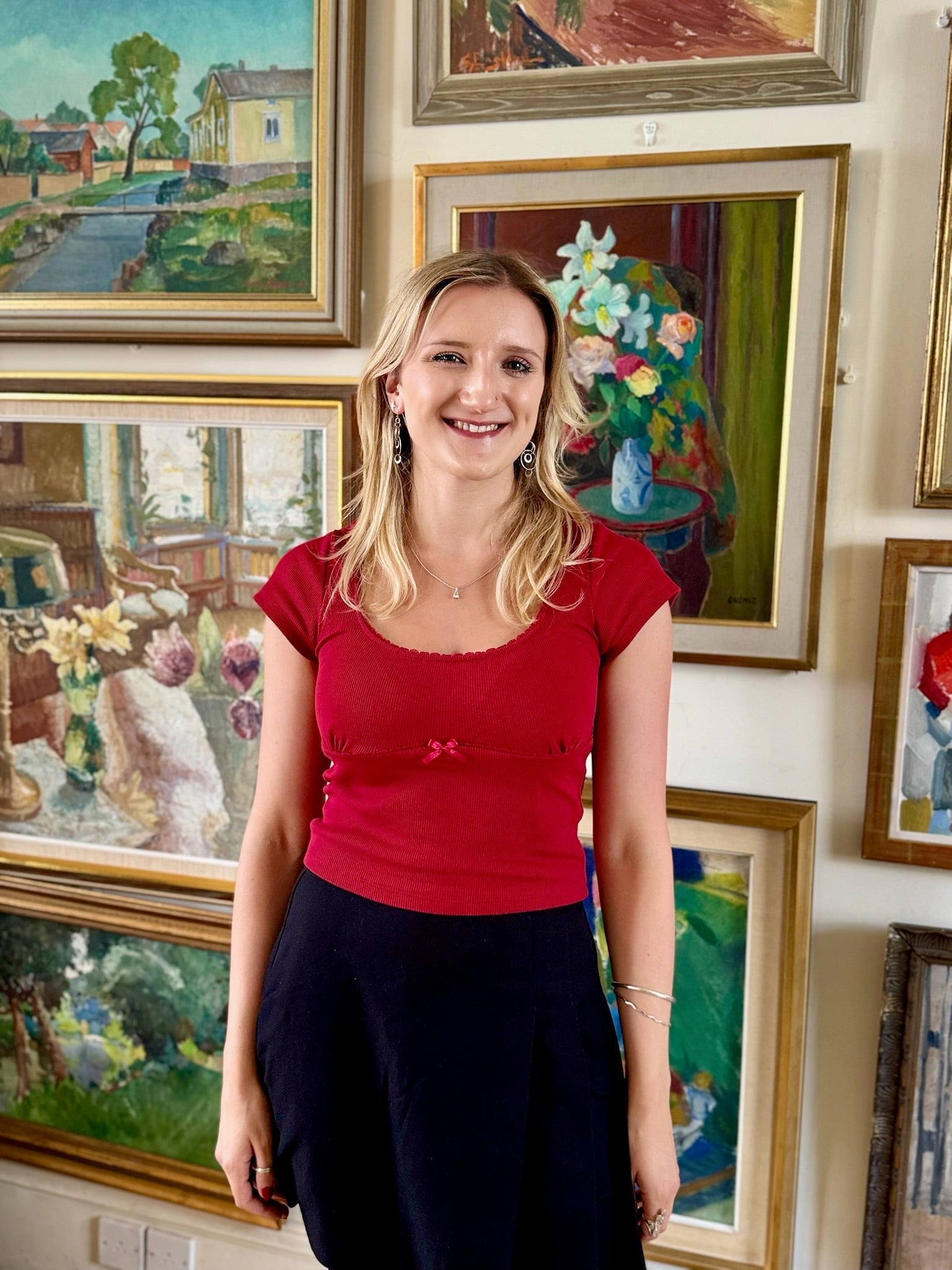Kitchen Art
For a long time, the idea of hanging art in the kitchen raised more eyebrows than enthusiasm. “Won’t it get ruined?” “Too much steam!” “Isn’t the kitchen just too…... messy?”, although that isn't to say that it hasn't been done. Just look at Elizabeth Garouste's kitchen in Paris as featured in Architectural Digest.
But these days, the kitchen isn’t just a place for chopping onions and boiling pasta — it’s where we gather, talk, pour a glass of wine, and spend so much of our time. So it stands to reason that this vital, lived-in space deserves just as much care and beauty as the rest of the home. And yes, that includes art.
At Collins and Green Art, we love helping people live with art — not just in drawing rooms or hallways, but in kitchens, boot rooms, dining nooks and everything in between. A well-placed vintage painting or delicately coloured print can transform a kitchen, adding warmth, soul and character. But there are some important things to consider — both stylistically and practically — to ensure your artwork thrives.
Why art belongs in the kitchen.
Kitchens can often be dominated by sleek surfaces and practical materials. Think brushed steel, glossy tiles, stone worktops. Introducing pictures helps soften those hard edges and adds a sense of history, personality and charm.
Imagine a hand-coloured 19th-century botanical tucked beside your spice shelf, or a beautiful still life of crunchy green apples hanging above a breakfast banquette. These small moments of beauty help break up the visual monotony and make the kitchen feel less utilitarian, and more considered and lived in.

Green Apples by Eric Cederberg; please click on the picture for more information.
Choosing the right art for a kitchen.
When selecting art for the kitchen, think about tone, texture, and subject matter. We find that vintage works with a food or nature theme always work beautifully: fruit still lifes, rural landscapes, botanical prints, or fishing scenes — anything that subtly nods to food, nature or domestic life.
Framed engravings and antique etchings are a smart option for tighter spots. They’re often smaller, and when properly mounted and glazed, they're very resilient. For a bolder look, go for a large oil painting above a sideboard or on a feature wall — something with mood and texture to anchor the space, perhaps a bright abstract.
Also, don’t be afraid to mix — kitchens are places of life and bustle, and a gallery wall of varied pieces can feel far more inviting than one lonely canvas. Here I am at home rearranging a gallery wall running above a lovely old French desk we use as a sideboard. The kitchen is also a really good place to run wild with your children's creations. The kitchen in the house I grew up in was always covered in our school art whether we thought it was any good or not and you will spy a child's drawing in the photo below!

Where to hang art in the kitchen?
This is where it gets practical. The first rule is to avoid splash zones. Steam, grease and heat are the main enemies of artwork, so steer clear of hanging anything directly above a hob, sink, kettle or toaster. These areas see temperature shifts and condensation that can be damaging over time — especially to antique paper or unprotected canvases.
Better places to hang art include;
-
On walls away from direct heat sources
-
On an open shelf above the work surface
-
Above a dining bench or breakfast nook
-
On the end of a tall cupboard run
-
Above a sideboard or dresser
-
Propped on open shelving (leaned securely and not too close to cooking zones)
-
Even beside a back door or pantry entryway
Having said that I love the idea of using a very un-precious painting an the wall behind a hob. Its something I am intending to do in my new house, when I finally get there!
Protecting your art; practical tips.
For antique engravings, etchings and watercolours, framing is everything. We recommend using conservation-grade mounts (acid-free) and UV-protective glazing. This will help prevent the artwork from fading over time and protect it from moisture in the air. Ideally, use a sealed backing board too, to keep humidity out.
Oil paintings — especially on canvas — are more forgiving, but they still need care. Avoid hanging them near heat or moisture sources, and consider backing them with a breathable barrier board to help buffer any temperature shifts. A good quality antique or bespoke frame helps too, both aesthetically and practically, protecting the canvas edges and structure.
Even if the painting isn’t near steam or heat, harsh sunlight can still do damage. Try to avoid placing artwork where it’ll be exposed to hours of direct sun each day — or if it must go there, consider glazing with museum-grade UV-filtering glass.
A kitchen with a good extractor fan, openable windows, and general airflow is always better for art. You don’t need museum-level climate control — just a reasonably consistent temperature and some way for steam to escape.
 These beautiful hand coloured prints, hand framed in two tone green stripes and available on our website, would look fabulous in a kitchen or bar. Click on the image for details
These beautiful hand coloured prints, hand framed in two tone green stripes and available on our website, would look fabulous in a kitchen or bar. Click on the image for details
How to care for kitchen art.
Even with good framing and sensible placement, it’s wise to check in on your artwork every now and then.
-
Dust gently with a soft, dry cloth — no sprays or polishes
-
Check for any warping or signs of damp on the backboard
-
Look for fading in prints — especially if sunlight hits them
-
Have oil paintings cleaned professionally if they build up surface grime from cooking.
Ultimately, art should be lived with — not just hung in ‘safe’ rooms. With a bit of thoughtful placement and protection, you can absolutely enjoy beautiful, interesting pieces in the most lived-in space of all.
And when you choose a vintage painting you’re bringing something with its own history, into your everyday life. A painting in the kitchen becomes a conversation starter, a point of quiet pleasure when the kettle’s boiling or the sourdough is rising!.
It’s what makes a house feel like home. This the wonderful kitchen of Joanna of @joannasbanners full of creativity and colour. (If you don't know her hop over to her Instagram or click on the picture and have a look at her work; its brilliant.)
Need help choosing?
If you're thinking of adding art to your kitchen but aren't sure where to begin, we're always happy to help. Whether it’s a single statement piece or a group of prints, we can help you.
Drop us a line or come and visit the studio in West London — the kettle’s always on!
Julia Collins



